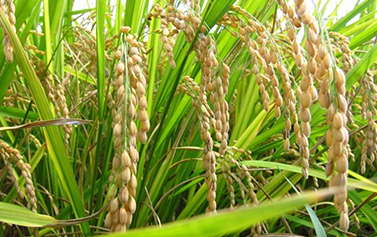Paddy/Rice

Rice or Oryza Sativa is a plant of Asian origin, primarily grown in India, China, Indonesia, Bangladesh, Thailand, Myanmar, Vietnam, Philippines and Pakistan. Asia accounts for around 90% of the world’s area under rice cultivation and close to 90% of the world’s rice is produced and consumed in this continent.
India has the world’s largest land area under rice cultivation, covering more than a quarter of the country’s total cultivated area and providing staple food to about 50% of the country’s population. Rice is an essential part of the daily meal in the southern and eastern India while in the wheat-dominated northern and central parts of the country, rice is consumed daily or during festivals and special occasions. Punjab, Haryana, Uttar Pradesh, Chhattisgarh, Bihar, Assam, Odisha, West Bengal, Andhra Pradesh and Tamil Nadu are the major rice producing states in India.
Nutritional and Medicinal Value
With Carbohydrate (starch) as a key component, Rice is a nutritional staple food providing instant energy. Rice provides one-fourth of our protein requirement and it is also the principal source of vitamins and minerals. Rice protein is the richest source of biological protein among cereal proteins due to the high true digestibility, high lysine content and superior net protein utilization. But, it is low on nitrogenous substances (only 8% average composition) and has 1% fat content or lipids.
Due to the rich starch content of rice, various food materials are made out of rice flour and brewers even use it for making alcoholic malt. Similarly, rice straw is mixed with other materials to produce porcelain, glass and pottery. Rice has variable composition and characteristics depending on the variety and climatic conditions under which the crop is cultivated.
Ideal Soil and Climate
This important cereal is grown on a wide variety of soils with low permeability and pH ranging between 5.0 to 9.5. Rice is grown on loamy sands in Punjab to heavy clay loams in Andhra Pradesh. The crop is cultivated under widely varying conditions of altitude and climate. Rice is annually grown under four major ecosystems viz., irrigated, rainfed lowland, rainfed upland and flood-prone.
Rice requires a hot and humid climate. Regions having high humidity, prolonged sunshine and an assured supply of water are considered ideal for the cereal. Rice requires an average temperature of 21 to 37º Celsius and is sown between the months of May – June every year.
Rice – All India Area and Production
| 2018-19 | 2019-20 | 2020-21 | 2021-22 | 2022-23 |
|
| Area (Million Hectares) |
44.2 | 43.7 | 45.8 | 46.4 | – |
| Production (Million Tonnes) |
116.5 | 118.9 | 124.4 | 129.5 | 135.7 |
Source:Directorate of Economics & Statistics, Department of Agriculture and Farmers Welfare.
2nd Advance Estimates of Production of food Grains for 2023-24
Rice Exports
India is the largest rice exporter in the world expanding its footprint in the African, Asian and European Union markets. According to the Ministry of Commerce and Industry, India’s rice exports (Basmati and Non-Basmati) increased by 20% to 21.2 million tonnes in 2021-22, from 17.7 million tonnes in 2020-21.
In value terms, India’s rice exports went up by 10% to USD 9,671 million in 2021-22 from USD 8,829 million reported in 2020-21.
Rice Exports from India
| 2019-20 | 2020-21 | 2021-22 | 2022-23 | 2023-24* |
|
| Value (Rs. Crore) |
45,426.65 | 65,404.73 | 72,115.63 | 89,622.09 | 68,360.50 |
*2023-2024 (April – January)
Source: Department of Commerce, Ministry of Commerce and Industry, Govt. of India
https://tradestat.commerce.gov.in
Iran, Saudi Arabia, Iraq, United Arab Emirates, Yemen, United States of America, Kuwait, United Kingdom, Oman and Qatar were the top ten export destinations for Indian Basmati rice in 2021-22.
On the other hand, Bangladesh, Benin, China, Nepal, Cote D Ivoire, Senegal, Togo, Guinea, Vietnam, Madagascar, Sri lanka constituted 66% of India’s non-Basmati rice exports in 2021-22.
References:
Handbook of Agriculture, Indian Council of Agricultural Research, August 2021
Textbook of Field Crops Production: Foodgrain Crops, Volume-I, Indian Council of Agricultural Research, August 2021
https://farmer.gov.in/cropstaticsrice.aspx
https://www.apnikheti.com/en/pn/agriculture/crops/cereals/rice
DGCIS Annual Export (Basmati rice (apeda.gov.in), Non Basmati Rice (apeda.gov.in)
